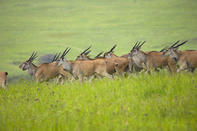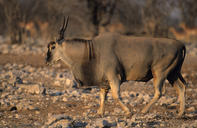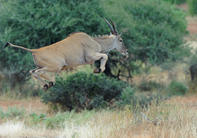Nomadic

Eland are unusual antelope in the bushveld in that they are nomadic and as such do not defend territories. They move around following the best feeding resources, sometimes in aggregations numbering a thousand animals, and their breeding is governed by a system of seasonal temporary association.
During the breeding season females, sub-adults and mature bulls (up to six) occur together in herds. After breeding is over, the males separate out from the herds and occur as bachelor groups or alone.
The females separate from the younger animals which stay together in nursery herds and seem to be more closely bonded to one another than to their mothers. The females and nursery herds join up again at the next breeding season and are subsequently joined by the males at this time too.
A system of rank determined by size and age exists to keep some order amongst the groups. Males are always dominant over females and older (and hence larger) animals over younger. The hierarchy is maintained by subtle ritualized threats which, if not responded to appropriately by an inferior animal, are followed through with persuasive jabs of the horns.
Males in a herd will automatically size each other up and give way to stronger-looking animals without question. Equally matched bulls will fight over females in oestrus, sometimes to the death, by horn-locking and pushing and twisting.
Unusual Techniques

Older bulls take on a blue-grey colour and have spectacular dewlaps and impressive thick necks. These strong necks give eland bulls the power that they need to twist and push one another off balance during fights for access to females on heat.
They have a mop of hair on their heads between their horns which covers a glandular region and this region is regularly coated in mud and is smelly from rubbing it where females have urinated or from ploughing up soft ground.
These actions, as well as the thrashing of bushes with their horns and loud bellowing, are demonstrations of dominance. Eland bulls are able to snap tree trunks 4 cm thick with their horns to display their aggression.
Both sexes in a herd of eland practice urine testing and flehmen (facial grimace which pumps steroid hormones into the Organ of Jacobsen on the roof of the mouth). This is unusual as usually, only the male of the species uses these techniques in order to determine a female’s readiness to mate.
Predators Beware

Adult eland are almost immune to predation due to their enormous size but the young are more vulnerable. Eland females are renowned for their tendency to cooperatively protect their young chasing off large predators to give the smaller animals a chance to bunch together and run to safety.
Although adult eland run away readily from disturbances and can cover distance very quickly at a gallop, they do tend to stand their ground against predators that they probably wouldn’t outrun, bunching heads-together and leaving the offender with a wall of powerful, kicking legs with which to contend.
Eland are athletic jumpers and can easily clear fences two meters high from a standing position. Eland walk extremely fast. The rate is so quick that humans can not keep up with them on foot. Their trotting gait also allows them to cover ground very rapidly. These are probably both adaptations to being nomadic.
Although newborn eland calves can stand almost immediately and are able to walk and follow an adult after three or four hours, they engage in what is known as a lying-up period. During the first two weeks of its life, the calf will hide in long grass or shrubbery. It is visited by its mother to suckle. T
he lying-up period affords youngsters some time to grow and develop strength before they have to deal with the pressure of keeping up with a moving herd.
By Megan Emmett